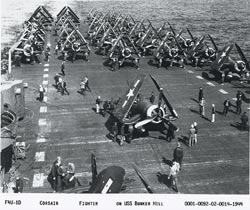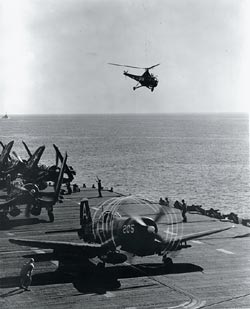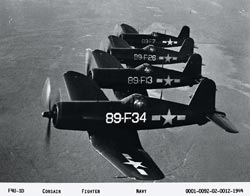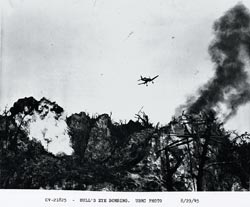|
Designed in 1938 and flown in 1940, Corsairs first tasted combat at Guadalcanal. It was at the “Canal” that Corsairs definitely established their aerial superiority over the vaunted Japanese Zero a highly maneuverable aircraft that had previously outperformed all U.S. fighters. The Corsairs were the first American fighters to top 400 miles per hour, and the first to house a 2,000 horsepower engine, making the gull-wing Corsairs the toughest foe faced by enemy pilots. Interrogation of high Japanese brass at the end of the war disclosed the fact that they considered the Corsair the top fighter in use by any service in the Pacific.
 After spending most of 1944 in clean-up actions in the South and Central Pacific (during which time the Corsair came into its own as a dive bomber, attack plane and night fighter), the F4U’s now were with Task Force 38, and destined to become the world’s No. 1 carrier-based fighter. After spending most of 1944 in clean-up actions in the South and Central Pacific (during which time the Corsair came into its own as a dive bomber, attack plane and night fighter), the F4U’s now were with Task Force 38, and destined to become the world’s No. 1 carrier-based fighter.
On March 4, 1944, the Corsair performed its first mission as a dive bomber in an attack on Mille island, Mille Atoll, in the Marshall Islands.
During the 7 weeks following this baptism as a fighter-bomber, Corsairs dumped more than 200,000 pounds of bombs on Japanese installations in the Marshalls.
British pilots used their Corsairs as bombers in the attacks on Java in April 1944. Scarcity of enemy air operation was the main reason for the F4U’s use as a bomber in 1944.
On May 16, 1944, a Navy evaluation board, after a series of comprehensive comparisons between the F6F-3 Hellcat and F4U-1D, opined: “It is the opinion of the board that generally the F4U is a better fighter, a better bomber and equally suitable carrier airplane as compared with the F6F and it is strongly recommended that the carrier fighter and/or bomber complements be shifted to the F4U type.”
 The Corsairs closed out 1944 by going aboard the fast carriers with both Navy and Marine pilots assigned to fly them. Assignment to shipboard duty was the year’s supreme accomplishment for the F4U’s. It came none too soon as the Japanese were threatening the entire U.S. Fleet with kamikaze attacks, and their fighters were getting better and faster. The Corsairs closed out 1944 by going aboard the fast carriers with both Navy and Marine pilots assigned to fly them. Assignment to shipboard duty was the year’s supreme accomplishment for the F4U’s. It came none too soon as the Japanese were threatening the entire U.S. Fleet with kamikaze attacks, and their fighters were getting better and faster.
As a result of the growing kamikaze tide, VMF-124, the first Marine squadron to take Corsairs into combat, also became the first to operate from a carrier.
The Pacific Fleet high command, in a conference at Pearl Harbor on November 24-26, 1944, expressed much alarm at the kamikaze peril. A decision was made to increase the number of fighters aboard carriers to meet the menace. To accomplish this as an interim measure, the Navy called upon the Marines and their Corsairs.
The final year of the war, 1945, was to see shipboard Corsairs venture into the China Sea, performing combat sorties over Iwo Jima, Okinawa, the Philippines, Formosa, and Tokyo.
From Guadalcanal, spearheading the drive toward Tokyo, Corsairs took part in nearly every major campaign in the Pacific. Operating from island bases and Navy flattops, Corsairs in the Pacific fought in the skies over the Solomons, Rabaul, the Carolines, Peleliu, the Marshalls, Philippines, Iwo Jima, Okinawa and Japan.
Known to the Japanese as “whistling death”, and to its Marine pilots as the “Sweetheart of Okinawa,” the Corsair also made aerial history in areas other than the Pacific, among them, the Indian Ocean and North Sea.
Corsairs were flown in combat by the U.S. Marines, U.S. Navy, Royal Navy and New Zealand Air Force.
Rex Beisel and Lt Col Boyington
The name “Corsair” became synonymous with the names of Marine and Navy aces including Lt. Col. Gregory (Pappy) Boyington, Lt. Ken Walsh, Lt. Bob Hansen, CDR. Tommy Blackburn, Lt. Ira (Ike) Kepford, and a host of others.
The most famous pilot to take the Corsair into action was Col. Charles A. Lindbergh. In one attack on Wotje Atoll, he took off in a Corsair with a bomb load of 4,000 pounds, the heaviest load ever carried up to that time by a single-engine fighter.
In the course of shooting down 2,140 enemy aircraft, only 189 Corsairs were lost in combat, a ratio of better than 11 to one.
From February 13, 1942, when a handful of Corsairs first engaged the Japanese at Guadalcanal, until V-J Day, Corsairs carried out a total of 64,051 action sorties. Of this total, 54,470 were flown from land bases and 9,581 from the decks of aircraft carriers.
 Marine Pilots led the Corsair onslaught. Operating from island airstrips, they shot down 1,400 enemy planes. Of that number, 1,100 were fighters and 300 bombers. Marine air losses were 141 Corsairs shot down. Marine Pilots led the Corsair onslaught. Operating from island airstrips, they shot down 1,400 enemy planes. Of that number, 1,100 were fighters and 300 bombers. Marine air losses were 141 Corsairs shot down.
A small number of U.S. Navy Corsairs accounted for 162 enemy planes with a loss of 14 of their own, giving a final tally of 1,562 enemy planes destroyed by land-based Corsairs.
Later, after being assigned to aircraft carriers, Corsairs shot down 578 enemy planes with a loss of only 34 F4U’s in air combat. Although the first landing of a Corsair aboard a carrier took place September 25, 1942, the Navy did not begin carrier operations with the planes until late 1944. The first Marine Air Group, MASG-48, was assigned its first carrier, USS Block Island on February 4, 1945. A Marine Squadron, VMF 124, however, began operating from the USS Essex December 28, 1944.
 One Corsair was the only airplane ever to receive an official citation. Corsair 122, operating with the Marine Devildogs squadron, was cited as follows: One Corsair was the only airplane ever to receive an official citation. Corsair 122, operating with the Marine Devildogs squadron, was cited as follows:
“In accomplishing her 100 missions, Corsair No. 122 logged more than 400 hours flying time, her total hops, including tests and reconnaissance flights, reached an amazing total of 178. Built for air combat, Corsair 122 proved her versatility by accepting 1000-pound bombs slung from her belly, and without strain or protest developed into the hottest dive bomber with wings. Were there blood in her fuel line instead of 100 octane, she would be wearing the Purple Heart, for the patch on the leading edge of her wing attests the accuracy of Japanese antiaircraft fire. She has covered all the Japanese based in the Marshall Islands like the morning dew.”
By the end of the Okinawa campaign, nearly every carrier the Navy had was equipped with Corsairs, and the way was paved for the peacetime years that lay ahead.
In the final year of the war, 3,575 Corsairs were produced, 2,046 by Chance Vought Aircraft, 1,529 by Goodyear.
More F4U:
Operation Summary WWII
WWII Record
WWII Corsair Aces
Production
Lindbergh, Clark and a 4000lb Bomb Load
Operation Summary Post WWII
|